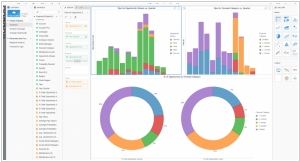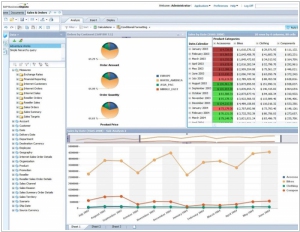MicroStrategy vs SAP Business Objects
May 25, 2023 | Author: Michael Stromann
10

MicroStrategy is a leading global provider of enterprise software platforms for business intelligence (BI), mobile intelligence, and network applications. The best business decisions are driven by data. World class organizations operationalize business intelligence and embed analytics in their DNA. MicroStrategy supports a full range of analytic functionality, from stunning business dashboards to sophisticated statistical analysis and data mining. Our platform gives you the flexibility to start small and seamlessly scale to an enterprise deployment.
7

Empower your people with easy access to the business intelligence (BI) and data visualization tools solutions they need to make faster, more informed decisions. Our BI platform and software can boost your organization’s collective IQ by giving all users the information necessary to drive smarter processes, improve performance, and become more effective in everything they do.
MicroStrategy and SAP Business Objects are both popular business intelligence (BI) platforms but differ in several key aspects:
1. Product Focus: MicroStrategy is known for its robust analytics and data visualization capabilities, emphasizing self-service analytics and mobile BI. It offers a comprehensive set of tools for data discovery, interactive dashboards, and advanced analytics. SAP Business Objects, on the other hand, provides a broader suite of BI tools, including reporting, ad hoc query, and data exploration, with a focus on enterprise reporting and integration with SAP's ecosystem.
2. Architecture: MicroStrategy follows a unified architecture, providing a single integrated platform for data modeling, report development, and data visualization. It offers a consistent user experience across different components. SAP Business Objects, on the other hand, consists of multiple standalone tools, each with its own specific purpose, which allows for more flexibility but may require additional integration efforts.
3. Scalability: MicroStrategy is known for its scalability and high-performance capabilities, making it suitable for large enterprise deployments with complex data environments. It can handle large data volumes and support a high number of concurrent users. SAP Business Objects also offers scalability but may require additional configuration and optimization for large-scale implementations.
4. Integration: SAP Business Objects has strong integration capabilities with SAP's other enterprise software solutions, such as SAP ERP and SAP HANA. It provides seamless connectivity and access to SAP data sources and systems. MicroStrategy, while it can integrate with various data sources and databases, is not specifically tailored to integrate with SAP systems.
5. User Experience: MicroStrategy focuses on providing an intuitive and user-friendly experience, making it accessible to both business users and IT professionals. It offers self-service analytics capabilities and interactive visualizations. SAP Business Objects provides a more traditional enterprise reporting experience, with features like pixel-perfect reporting and scheduled report distribution.
See also: Top 10 Business Intelligence software
1. Product Focus: MicroStrategy is known for its robust analytics and data visualization capabilities, emphasizing self-service analytics and mobile BI. It offers a comprehensive set of tools for data discovery, interactive dashboards, and advanced analytics. SAP Business Objects, on the other hand, provides a broader suite of BI tools, including reporting, ad hoc query, and data exploration, with a focus on enterprise reporting and integration with SAP's ecosystem.
2. Architecture: MicroStrategy follows a unified architecture, providing a single integrated platform for data modeling, report development, and data visualization. It offers a consistent user experience across different components. SAP Business Objects, on the other hand, consists of multiple standalone tools, each with its own specific purpose, which allows for more flexibility but may require additional integration efforts.
3. Scalability: MicroStrategy is known for its scalability and high-performance capabilities, making it suitable for large enterprise deployments with complex data environments. It can handle large data volumes and support a high number of concurrent users. SAP Business Objects also offers scalability but may require additional configuration and optimization for large-scale implementations.
4. Integration: SAP Business Objects has strong integration capabilities with SAP's other enterprise software solutions, such as SAP ERP and SAP HANA. It provides seamless connectivity and access to SAP data sources and systems. MicroStrategy, while it can integrate with various data sources and databases, is not specifically tailored to integrate with SAP systems.
5. User Experience: MicroStrategy focuses on providing an intuitive and user-friendly experience, making it accessible to both business users and IT professionals. It offers self-service analytics capabilities and interactive visualizations. SAP Business Objects provides a more traditional enterprise reporting experience, with features like pixel-perfect reporting and scheduled report distribution.
See also: Top 10 Business Intelligence software


